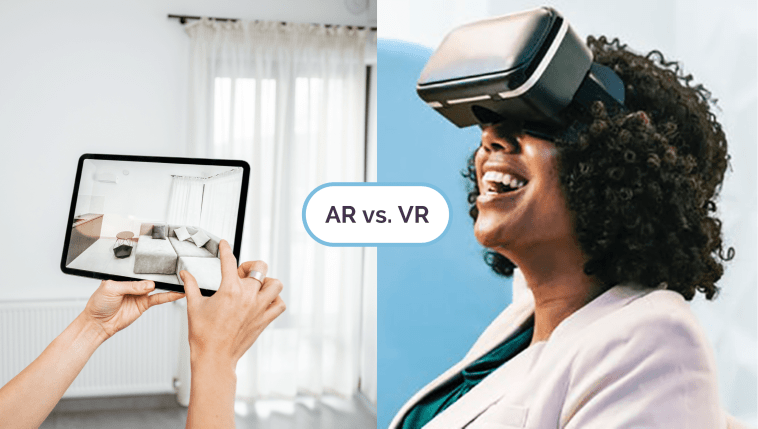Modern devices with screens like smart TVs, smartphones, and computers have become a part of our lives. AR (Augmented Reality) and VR (Virtual Reality) are two dramatically emerging technologies that are transforming how we use these screens.
Recent statistics show that there will be more than 2.5 billion people using these technologies by the year 2027. They provide us with a simulated environment by replacing or enhancing the real-life one so that we can interact with the digital content in a more immersive way.
While AR and VR share several similarities, they’re actually different. In this article, we’ll discuss these two technologies in detail to help you understand how they’re different from each other and what their real-life applications are.
What is AR (Augmented Reality)?
Definition for Google Snippet: AR (Augmented Reality) is a technology that creates an artificial environment by combining the digital world and a real-world physical environment. In simpler words, it enhances your surroundings by adding digital elements and allows you to interact with them in real-time using a device like a smartphone or a camera.
Example:
AR technology is commonly used in sports events to display dynamic score overlays and statistics. For instance, in American football broadcasts, you might see virtual lines indicating the line of scrimmage, first-down markers, and player statistics overlaid onto the field in real-time.
Another popular example of AR is the Pokemon Go game, where players move around the real world to capture virtual creatures.
What is VR (Virtual Reality)?
Definition for Google Snippet: VR (Virtual Reality) is a computer-generated 3D environment/simulation that obscures the natural world but appears to be real. To experience fully immersive VR technology, you need to use specialized devices, such as a VR headset.
Example:
Aircraft pilots can undergo virtual reality training to simulate different flight scenarios. Using VR headsets and realistic cockpit setups, they can experience lifelike flying conditions while remaining safely on the ground.
It allows them to practice takeoffs and landings and experience critical situations like engine failures or severe weather. This way, they can refine their skills, improve decision-making, and enhance muscle memory before facing real-life flight challenges.
Other than that, VR technology is also used in other industries for different purposes, such as VR games, VR tours for the travel industry, and VR programs for medical training.
Distinctions Between AR and VR
While both AR and VR technologies offer simulated reality experiences, they differ in their fundamental components.
VR typically involves the use of a headset that takes the user to a virtual world. Whereas AR blends the real and virtual worlds together, and the simulated environment it offers can be experienced using smartphones, tablets, and cameras.
Here’s a detailed chart that explains the differences between the two technologies.
| Properties | AR | VR |
| Impact | Enhances the real world with the help of virtual elements | Only creates a fictional reality |
| Devices Required | Devices with screens like smartphones and cameras (AR glasses are also used) | Motion-tracking devices like VR headsets and VR glasses |
| Interaction | With the blended mixture of real and virtual world | With a computer-generated environment and objects |
| Comfortability | More comfortable than VR and can be used for longer periods without dizziness or eye strain | Less comfortable and can cause dizziness and/or eyestrain |
| Cost | Less expensive as it uses elements from the real world | More expensive as the entire environment needs to be created |
| Applications | eCommerce, sports, tourism, retail industry, architecture, construction, healthcare industry, education, gaming, and marketing | Healthcare industry, design, and prototyping, entertainment industry, training simulations, tour guides, gambling, games |
| Control | Allows you to control your presence | Visual senses are controlled by the system |
| Bandwidth Requirement | Requires more bandwidth (500 Mbps or above for 4K resolution for the best experience) | Requires less bandwidth (100 Mbps with 1 millisecond or less latency for the best experience) |
| Revenue Growth | Expected to reach $597.54 billion by 2030 | Expected to reach $435.36 billion by 2030 |
Advantages and Disadvantages of AR and VR
Both AR and VR come with their own sets of advantages and disadvantages that you should know. It’ll help you better understand the differences between the two technologies.
Augmented Reality
Here are the lists containing the advantages and disadvantages of augmented reality.
Advantages
- Enhanced User Experience: AR enriches user experiences by enabling interaction with virtual elements in real-world surroundings, which leads to more engaging and immersive interactions.
- Interactive Learning: Another excellent advantage of AR is that it can transform learning by allowing users to engage with virtual objects in real contexts. It makes education more interactive and enjoyable.
- Cost Reduction: AR can also reduce production costs by enabling users to preview and understand how products and services will function before mass production.
- Increased Efficiency: This technology can boost efficiency across different sectors like medicine, tourism, education, and more by providing real-time information and assistance.
- Business Opportunities: Augmented reality also has the power to help businesses make more sales. It can work as a marketing tool for interactive and captivating ad campaigns, allowing users to visualize products before buying.
Disadvantages
- Hardware Requirement: To utilize the power of AR, you need to use specific hardware like smartphones or tablets for user experience, which limits accessibility to compatible devices.
- Accuracy Limitations: The accuracy of overlaying virtual elements in the real world depends on device capabilities, and it can be limited.
- High Costs: Although AR is cheaper than VR, developing high-quality AR experiences can still be pretty costly. It can make it harder for small businesses with tight budgets to adopt this technology.
- Motion Sickness: Prolonged AR use can lead to motion sickness in some individuals due to the sensory dissonance between real and virtual elements.
Virtual Reality
The following lists explain the advantages and disadvantages of virtual reality.
Advantages
- Immersive Experience: VR provides unparalleled immersion as it transports users into virtual environments and allows them to feel fully present in them, which are otherwise inaccessible.
- Time and Cost Savings: Interaction within virtual environments can save both time and money because you don’t have to travel or build physical models to try out ideas or test things.
- Accessibility: VR technology is open to everyone as it only requires a compatible device. It means that everyone, including people with disabilities or physical limitations, can experience it.
- Entertainment: VR technology allows developers to build captivating games and movies that can be even more thrilling and engaging than regular forms of entertainment.
- Training and Education: Virtual Reality is great for training and education because it allows professionals and students to practice difficult situations safely. For instance, the example of Aircraft pilots discussed above.
Disadvantages
- Physical Discomfort: One of the biggest disadvantages of VR is that it makes some people experience nausea, dizziness, and/or eyestrain.
- Expensive Equipment: Most devices that can run VR are pretty expensive because they require high computing power and advanced technology for optimal functioning.
- Social Isolation: One of the biggest downsides of VR is that it creates a virtual world that’s completely isolated from the real one. It can also be addictive, which means people can become detached from real-life relationships.
- Control Issues: Learning to control movements in the virtual environment can take some time for some users, and it can cause discomfort and frustration.
Applications of AR and VR
Now that you understand what AR and VR technologies are and how they’re different from each other, it’s time to discuss their real-life applications.
Augmented Reality
Augmented reality has a multitude of applications connected with different industries, and here’s a list of the most important ones.
Advertising and Marketing
Augmented reality is becoming increasingly popular in the advertising and marketing industry. That’s because it allows marketers to create engaging experiences for consumers.
A popular example of this AR in advertising and marketing is the Stranger Things Experience by Netflix. It was an experimental marketing campaign that allowed the fans to visit a physical Netflix location and be a part of an augmented reality experience related to the show.
This program included AR features and games to make fans feel that they’re actually in the Stranger Things world.
E-commerce and Retail
Augmented reality is used in the retail sector to enhance customer experiences and minimize returns. There are AR apps that enable customers to visualize how products would look in their own space before making a purchase.
This ‘try before you buy’ approach improves user satisfaction and reduces the chances of disappointment upon delivery.
For example, the popular furniture brand IKEA allows its customers to use AR technology in order to visualize and test products they want to buy before making their final decision.
Tourism and Culture
In the tourism industry, AR provides real-time information about attractions and cultural sites. For instance, tourists visiting a museum can use AR to point their cameras at artworks and access additional information about them instantly.
Navigation
AR technology is transforming navigation by turning it into an interactive and user-friendly experience. For example, the live view by Google Maps overlays digital navigation instructions onto the actual surroundings to guide users.
This feature can be invaluable in large spaces like shopping malls or airports to help users navigate complex environments more efficiently.
Education
Augmented reality can enhance the education sector as well. It provides students with three-dimensional models that they can examine from different angles. Teachers can also use AR to create immersive learning experiences to engage students in a more interactive way.
For instance, in subjects like biology, students can visualize, zoom, and rotate 3D models of cells or organs overlaid in the classroom to understand how they work.
Healthcare
AR technology is being used in the healthcare industry in multiple ways, like for patient education and physician training. Surgeons can utilize it to overlay critical patient information, diagnostic images, or procedural instructions directly onto the surgical area.
Architecture, Design, and Construction
AR can help professionals in architecture and design by allowing them to visualize how structures will appear in the real world before construction. Architects can use it to create virtual models that demonstrate how a building will fit into its environment. It can help them a great deal with design decisions and planning.
Logistics and Warehousing
Augmented reality is transforming how workers handle picking and packing tasks. This is typically achieved by using AR glasses, which provide real-time visual guidance to individuals. It allows them to see digital cues, directing them to the right items and the most efficient paths to take.
Not only does it minimize errors that can occur during these tasks, but it can also improve the overall productivity of workers.
Virtual Reality
Virtual reality also has a wide range of applications, including the following.
Training and Education:
Just like augmented reality, virtual reality is also used in training and education. It can replicate real-world scenarios for professionals and students to practice in a controlled environment.
Medical students, for instance, can use VR to rehearse surgical procedures without risking harm to real patients. It can help them improve their skills and confidence before entering actual clinical settings.
Entertainment
VR has been used in the entertainment industry since the early-mid 1990s. We now have VR video games, movies, and concerts that allow users to engage with content in a highly immersive manner.
For instance, in VR games, players move and interact with the environment as if they were really there, which creates an exciting and captivating experience.
Therapy
Another important use of VR technology is that it can aid in the treatment of both mental and physical disorders. VRET (Virtual Reality Exposure Therapy) is used to help individuals confront phobias or anxieties gradually and safely.
It recreates feared situations in a controlled environment and helps patients learn coping mechanisms to reduce their fear responses.
Virtual Tourism
Virtual reality offers immersive virtual tourism experiences to users so that they can explore remote and/or hazardous locations without real-world risks. Additionally, it also provides people with an opportunity to visit places virtually that may be financially out of their reach in reality.
Exercise
There are VR apps, such as FitXR, that allow people to perform exercises in a virtual environment. The virtual setting adds an element of excitement, which makes workouts more enjoyable and motivating.
Real Estate
Virtual Reality is revolutionizing the real estate industry by enabling immersive property exploration. It allows buyers to take virtual tours of properties they’re interested in from their homes, which eliminates the need for physical visits and enhances decision-making.
AR and VR: Technology Challenges
While AR and VR are both powerful technologies and have the potential to transform the digital landscape, they’ll still take some time to become fully mainstream because of the following challenges.
Limited Processing Capability
One of the biggest challenges in the widespread adoption of AR and VR is the limited processing power of mobile devices. These technologies demand high computational resources to render immersive and realistic experiences, and most mobile devices that we have currently lack that.
To overcome this challenge, we need advancements in mobile hardware, including faster processors and enhanced graphics capabilities. It’s also possible to minimize the intensity of this problem by offloading some processing tasks to cloud-based servers. But doing so introduces another challenge: limited bandwidth.
Limited Bandwidth
While cloud-based processing can be a solution to the processing bottleneck, the current state of mobile network bandwidth might not be enough for this task. Real-time video processing is a key requirement for AR and VR applications and demands high-speed and reliable mobile connectivity.
The 5G technology has the potential to minimize this issue, but it still lacks the infrastructure needed for its widespread adoption.
Complex Development
Developing AR and VR applications is a complex, resource-intensive, and expensive process. Creating immersive environments, integrating real-world interactions, and ensuring optimal performance requires specialized skills and expertise.
The evolution of development tools equipped with AI (Artificial Intelligence) capabilities can help with this problem.
Inconvenient VR Hardware
This challenge is specifically related to VR. The headsets that you need to wear to experience this technology can be tiring. Additionally, users might also need to dedicate physical space before wearing a headset, depending on the app. These hurdles are arguably the biggest factors that affect the seamless adoption of virtual reality.
It’s important to note that companies are continuously striving to design innovative products, such as Vision Pro by Apple, that offer a comfortable VR headset-wearing experience. However, the goal of achieving round-the-clock usability of these devices is still a work in progress.
Security and Privacy Issues
One of the biggest concerns about AR/VR technologies is that they can have a negative impact on user privacy and security. They can collect a lot of information about the user, such as voiceprints, face geometry, handprints, fingerprints, and retina scans.
This information is more personal and critical in nature than what other forms of technology collect. If cybercriminals get their hand on this data, then the loss of privacy will be huge. To mitigate this risk, you can use security tools like VPN (Virtual Private Network), firewalls, and anti-malware/virus solutions.
Final Words
While both augmented reality and virtual reality present certain challenges and have downsides, the benefits they bring outweigh them.
These technologies really have the potential to revolutionize every industry linked to the digital world and transform how we perceive and interact with the world around us.
We hope this guide has helped you understand how AR and VR technologies work, what are the differences between them, and how they’re reshaping different industries.




